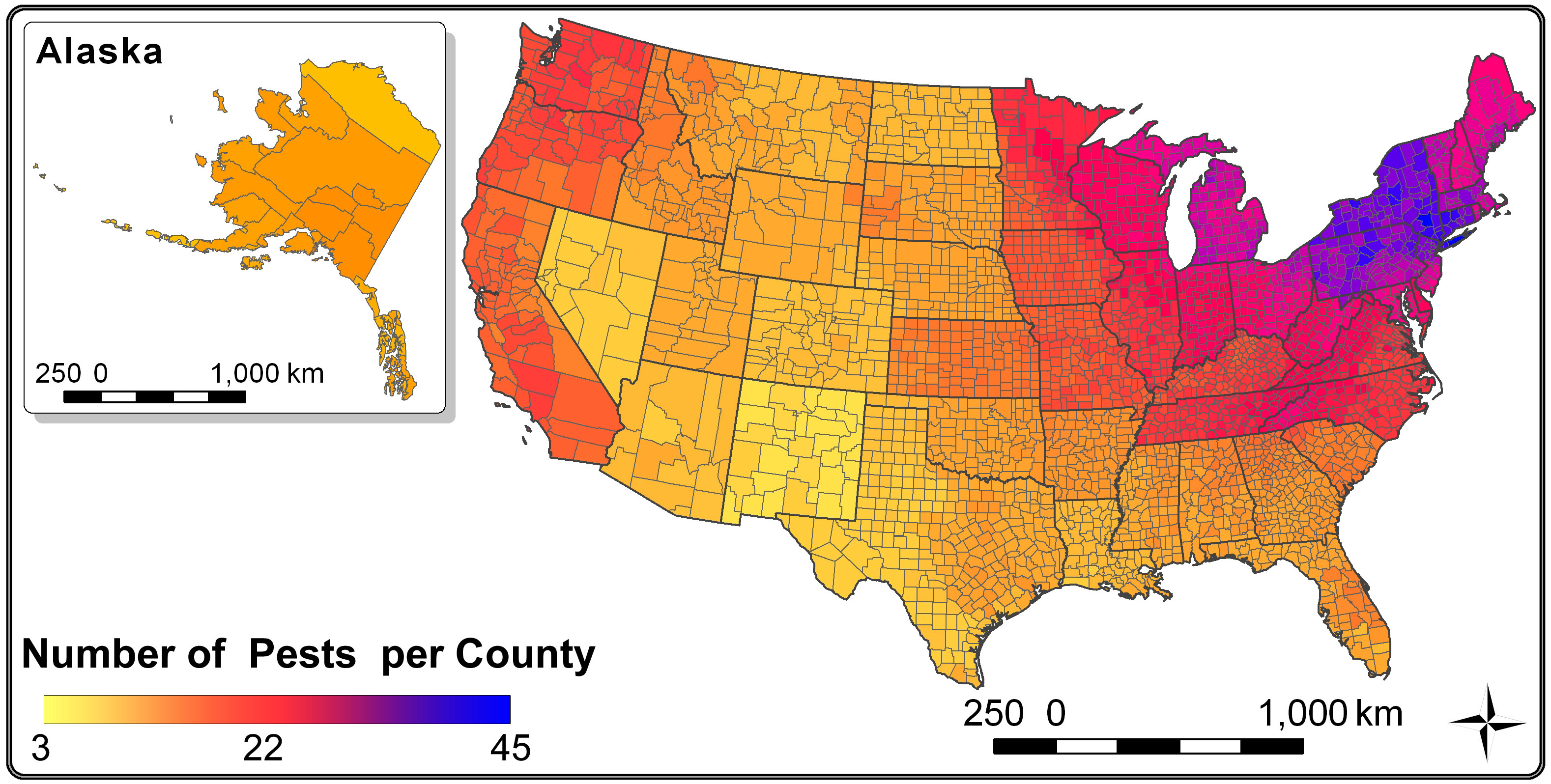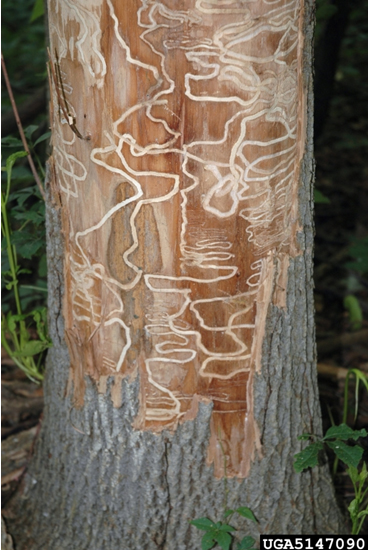Outlook for Ash in Your Forest:
Results of Emerald Ash Borer Research and Implications for Management
Kathleen S. Knight
Since its accidental introduction near Detroit, Michigan, in the mid-1990s, emerald ash borer (EAB) has rapidly spread through much of the U.S. and adjacent Canada, leaving millions of dead ash trees in Midwestern states (4,11). Unfortunately, EAB attacks trees as small as an inch in stem diameter and it attacks all five ash species native to the region – white, green, black, pumpkin, and blue. Nearly 100% of the trees attacked by the beetle eventually die (5, but see 10).
Yearly monitoring of ash forest sites across Ohio began in 2005 to understand the effects of EAB on ash populations and forests. Several interesting results have emerged. Mortality was first evident in northwest Ohio sites in 2006, most of the Toledo area plots reached >95% mortality of ash trees by 2009, and many of the central Ohio sites had reached >95% mortality by 2013. At a single stand scale, it can take 3 to 6 years for the ash trees to decline from healthy to nearly complete mortality (Figure 1). 
The loss of ash from forest ecosystems may cause a cascade of effects (3), from growth of competing trees that now find themselves with less competition, to invasive plant species taking advantage of the light that reaches the forest floor as canopy gaps open, to massive amounts of coarse woody debris piling up in ash floodplain forest, to effects on insects and wildlife. We have shown how maples and elms grow rapidly in response to ash mortality, how forest productivity can decline due to EAB (2), and how woodpeckers take advantage of the new food source EAB larvae provide (1). The largest effects of EAB are most likely to be seen where ash trees are the dominant species in the canopy and few other tree species are poised to fill in the gaps left behind by the ash (2).
While collecting data in our northwest Ohio ash sites in 2009, we noticed a few surviving large healthy-looking ash trees within a sea of EAB-killed trees. We performed a complete survey of the site in 2010, two years after >95% of the ash trees at the site had died, and found 111 healthy “lingering” ash trees representing less than 1% of the original population of over 11,000 ash trees (7). We have continued to monitor these trees, and many of the trees have remained healthy although some have died. We are studying whether these ash trees might have natural tolerance or resistance to EAB, and the preliminary results from greenhouse experiments look promising. Research and controlled breeding efforts for these “lingering” ash trees are ongoing (8).
Ash produces mast crops of seeds approximately every 1-5 years, which can create carpets of newly germinated ash seedlings on the forest floor the two summers after the mast year. Unfortunately, the seeds do not appear to persist in the seed bank for more than a few years, and as the canopy ash trees die the periodic abundant production of ash seedlings is eliminated (5). In many sites, only an even-aged cohort of ash seedlings, too small to be attacked by EAB, remains after the canopy ash trees are killed. Ash seed collection efforts are underway to preserve ash germplasm (i.e., genetic resources) for future research and restoration efforts (9).
What do these findings mean for management of your woodlot, park, or forest? First, if you get a good mast year for ash seed, connect with the ash seed collection program to see if more collections are needed in your area (www.nsl.fs.fed.us). Next, decide whether you prefer to remove or treat the ash trees or to allow EAB to kill 99% of them. Although excellent insecticide options are available for landscape trees (11), it costs too much to deploy them across an entire forest. If you desire pre-emptive harvests, work with a forester to use good practices that will sustain forest cover and follow quarantine laws to avoid further spreading EAB. Ohio State University published management strategies for tree plantings and natural stands (see ohioline.osu.edu/for-fact/pdf/0059.pdf). Watch for and manage invasive plant species that may take advantage of conditions created by EAB, and plant other tree species in ash-dominated areas if necessary. If you opt for natural mortality, have a plan to deal with hazard trees (dead trees that could fall on people or property due to their location), and be on the lookout for “lingering” ash trees (at least two years after most trees have died) and let us know about them! I hope that we can use EAB as an opportunity to create more diverse and resilient forests in the future.
Literature Cited:
1. Flower CE et al. 2014. Forest Ecol. Manag. 313:300-306.
2. Flower CE, Knight KS, Gonzalez-Meler MA. 2013. Biol. Invasions. 15: 931-944.
3. Gandhi KJK & Herms DA. 2010. Biol. Invasions 12:389-405.
4. Herms DA & McCullough DG. 2013. Ann. Rev. Entomol. 59:13-30.
5. Klooster WS et al. 2013. Biol. Invasions DOI10.1007/s10530-013-0543-7
6. Knight KS, Brown JP, Long RP. 2013. Biol. Invasions 15:371-383.
7. Knight KS et al. 2012. PSW-GTR-240. USDA FS PSWRS. 143-152.
8. Koch JL et al. 2012. PSW-GTR-240. USDA FS PSWRS:235-239.
9. www.nsl.fs.fed.us
10. Tanis SR & McCullough DG. 2012. Can. J. For Res. 42:1542-50.
11. www.emeraldashborer.info
Acknowledgements:
Many collaborators have contributed to this research, including Robert Long, Dan Herms, Charles Flower, Jennifer Koch, Robert Ford, Kyle Costilow, Britton Flash, Rachel Kappler, Rachel Hefflinger, Wendy Klooster, John Brown, and Mary Mason. In addition, many summer employees and technicians have assisted in data collection and data entry. Funding was provided by the USDA Forest Service, USDA NRI grant program, ARRA, and USDA APHIS.
Kathleen Knight is a Research Ecologist with the USDA Forest Service, Northern Research Station located in Delaware, Ohio. Her current research deals with the effects of emerald ash borer on forest communities.
 Figure 1. Ash mortality at an EAB-infested site in northwest Ohio - one of the most rapidly declining sites we studied. Photo Credit: Emerald ash borer galleries (Art Wagner, USDA APHIS PPQ, Bugwood.org).
Figure 1. Ash mortality at an EAB-infested site in northwest Ohio - one of the most rapidly declining sites we studied. Photo Credit: Emerald ash borer galleries (Art Wagner, USDA APHIS PPQ, Bugwood.org).
